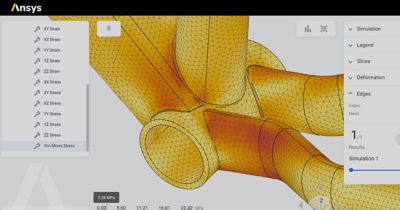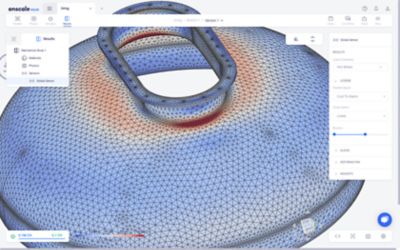-
United States -
United Kingdom -
India -
France -
Deutschland -
Italia -
日本 -
대한민국 -
中国 -
台灣
-
-
产品组合
查看所有产品Ansys致力于通过向学生提供免费的仿真工程软件来助力他们获得成功。
-
ANSYS BLOG
April 18, 2022
Our Heads Are in the Cloud
Some of you may remember the old saying: “She’s got her head in the clouds.” It was an indication that someone was a dreamer, maybe disconnected from the day-to-day realities of their world. How times have changed. We now live our life “in the cloud,” and most of the time we are not even aware of it.
The way we communicate via telephone, email, or messaging; the way we capture the moments of our lives with pictures and social media posts; the way we navigate our way on the roads (and hopefully avoid both traffic snarls and our local constabulary); the way we consume television, music, movies, books, and even The New York Times daily word or number puzzle we complete over breakfast — all of it is now dependent on the cloud. We talk to Siri and Alexa as if they are part of our family, asking them to find us a movie, increase the temperature, dim our living room lights, or to call home while we are driving, so we can let our real family know we’ll be there soon. What comes next?

Post processing in OnScale Solve
For Ansys, I believe what’s next will be that our world-class engineering simulation technologies will become the backbone of an ecosystem of applications and solutions, some of which we could only dream of even five years ago. Our industrial customer base currently uses our products to resolve their complex engineering challenges, and the cloud already gives them enormous flexibility to manage compute resources and remove location-based constraints on their engineering workforce. This is an enormous step forward, but it’s only the beginning of the cloud journey for our technology. Before the end of this year, we will have enabled our customers to use our core software products from any location, on any hardware, and via their own choice of cloud service provider, giving our customers direct control over the management of their cloud resources, while still enabling them to maximize the use of our technology to solve their engineering challenges.
Accelerating Our Cloud Strategy
Ansys just announced that it has entered into a definitive agreement to acquire OnScale, Inc. With OnScale’s technology, Ansys will extend its current marketplace and managed cloud portfolio to include a cloud-native, web-based user interface.
This acquisition will support and accelerate Ansys’ existing platform-centric approach to creating a new class of simulation-based, vertical applications by providing a cloud-native framework. At Ansys, our teams are already working on solutions that combine the physics and technologies of multiple products in value-added workflows, behind easy-to-use, intuitive user interfaces; embedding knowledge and expertise gained over multiple decades and enabling its use by non-experts from any location. We are also creating flexible, accessible, remote access to the core capabilities of our solvers, allowing engineers and scientists to leverage those capabilities to create solutions or applications that will solve problems they have identified using Python and other open-source toolsets.

“Customer needs are varied, and any successful cloud strategy must give customers the flexibility to adapt the use of cloud to their unique simulation challenges. To that end, our cloud strategy addresses the needs of not only existing customers, but any engineer, scientist or professional who can benefit from simulation technology,” said Shane Emswiler, senior vice president of products at Ansys, in a recent press release. “From enterprise customers who have invested heavily in simulation, to startups seeking flexible, scalable purchasing – Ansys provides organizations of all sizes with flexibility to leverage the cloud in ways that create maximum value for their teams.”
So, maybe it is time to redefine that old expression: Living with our heads in the cloud can still be about dreaming, but we’re making it about dreaming of all the ways Ansys technologies can be used to change the world we live in.
To learn more about Ansys’ expanding cloud offerings, register to attend Simulation World 2022, a virtual event taking place May 18, 2022.
Forward-Looking Information
This information contains certain forward-looking statements within the meaning of the Private Securities Litigation Reform Act of 1995 with respect to the acquisition, including statements regarding the benefits of the acquisition and the products and markets of each company. These forward-looking statements generally are identified by the words "believe," "project," "expect," "anticipate," "estimate," "intend," "future," "opportunity," "plan," "may," "should," "will," "would," and similar expressions. Forward-looking statements are predictions, projections and other statements about future events that are based on current expectations and assumptions and, as a result, are subject to risks and uncertainties. Many factors could cause actual future events to differ materially from the forward-looking statements including but not limited to: (i) the risk that the acquisition may not be completed in a timely manner or at all; (ii) the failure to satisfy the conditions to the consummation of the acquisition; (iii) risks that the proposed transaction disrupts current plans and operations of OnScale and potential difficulties in OnScale employee retention as a result of the transaction; (iv) the occurrence of any event, change or other circumstance that could give rise to the termination of the acquisition agreement; (v) risks related to diverting management’s attention from OnScale’s ongoing business operations; (vi) the ability of Ansys to successfully integrate OnScale’s operations, product lines, and technology; (vii) the short- and longer-term effects of the COVID-19 pandemic; (viii) the ability of Ansys to implement its plans, forecasts, and other expectations with respect to OnScale’s business after the completion of the acquisition and realize additional opportunities for growth and innovation; and (ix) adverse changes in the economic and political conditions in the regions in which Ansys and OnScale operate. In addition, please refer to the documents that Ansys files with the SEC on Forms 10-K, 10-Q and 8-K. These filings identify and address other important risks and uncertainties that could cause events and results to differ materially from those contained in the forward-looking statements set forth herein. Forward-looking statements speak only as of the date they are made. Readers are cautioned not to put undue reliance on forward-looking statements, and Ansys assumes no obligation to update or revise these forward-looking statements, whether as a result of new information, future events, or otherwise.










